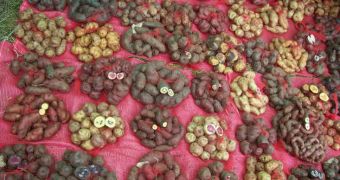In a development that could help fight the spread of poverty in the world's poorest countries, an international collaboration of investigators announces the creation of the newest, most detailed map of the potato genome.
The advancement could lead to the development of ultra-nutritious potatoes, that could be used to fight poverty in areas of Africa, India, and Third World countries. An international consortium of scientists worked heavily towards this goal, and the work is now finally completed.
For the first time ever, investigators know which specific genes in the plant's genome related to what specific function. This will soon allow them to start genetic manipulations of these traits, which will ultimately lead to the creation of more nutritious plants.
This was made possible by a difficult research effort, which was centered around sequencing and identifying relevant genes. With the new data, experts could even create potatoes that are less likely to be damaged by pests and infections, and that would rely less on pesticides and other chemicals.
Given that the potato is the most widely used, non-grain food in the world, it stands to reason that its popularity will increase considerably over the coming decades. Officials statistics from the United Nations show the world's population growing from 6.1 billion in 2000 to 8.9 billion in 2050.
By improving on the plant, and making it more nutritious, experts hope to cover at least some of the projected demand. Preparing for the emergence of a strong, potato-dependent population should be completed before the need actually arises.
Details of the new research were published in the July 10 online issue of the top scientific journal Nature. The work was funded by the US National Science Foundation (NSF). The original draft of the potato genome was released by the team in 2009, but now the full conclusions are in.
“Since our initial release of the sequence in 2009, we have improved the quality, identified and analyzed the genes and analyzed the genetic basis for the biology of the potato and its tuber,” explains Michigan State University plant biologist and consortium member Robin Buell.
“This is the first plant with a tuber to be sequenced. It will still take researchers awhile to use the genome information to improve its agronomic traits, such as improved quality, yield, drought tolerance and disease resistance,” she adds.
“But our most-recent research will accelerate efforts on improving potato varieties and help close the gap in bringing a better potato to the farmer,” the MSU investigator concludes.

 14 DAY TRIAL //
14 DAY TRIAL //